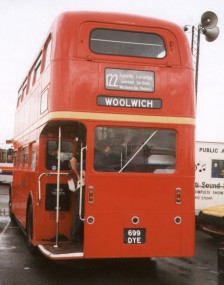 If you look at the plan of a London Routemaster, you'll see that the staircase is at the rear, at that the interior wall is curved, matching the curve of the exterior. You descend, first facing towards the rear, but then radidly turning to face towards the nearside. You can place your weight against the outside handrail, following the curve as you make your descent, working with the inertia of the forward-moving bus to keep you canted towards the side or rear of the bus all the time.
If you look at the plan of a London Routemaster, you'll see that the staircase is at the rear, at that the interior wall is curved, matching the curve of the exterior. You descend, first facing towards the rear, but then radidly turning to face towards the nearside. You can place your weight against the outside handrail, following the curve as you make your descent, working with the inertia of the forward-moving bus to keep you canted towards the side or rear of the bus all the time. On the sleek Enviro400 the staircase runs towards the back of the bus for most of its length (my photograph shows an Enviro500 in Hong Kong; for a UK vehicle see here). You start your descent facing the offside, that is you are working against the inertia of the moving vehicle. The panelling meets at a 90° angle, so there is no curve to lean against to transition from facing offside to facing towards the rear. Now you have a straight drop, facing to the rear in front of you, with the inertia of the bus propelling you down it. There is a correspondingly sharp angle to the panelling and stairs at the bottom.
On the sleek Enviro400 the staircase runs towards the back of the bus for most of its length (my photograph shows an Enviro500 in Hong Kong; for a UK vehicle see here). You start your descent facing the offside, that is you are working against the inertia of the moving vehicle. The panelling meets at a 90° angle, so there is no curve to lean against to transition from facing offside to facing towards the rear. Now you have a straight drop, facing to the rear in front of you, with the inertia of the bus propelling you down it. There is a correspondingly sharp angle to the panelling and stairs at the bottom. In short, in my opinion, the Routemaster stairs assist you in descending, the Enviro400’s actively work against a safe descent.
In short, in my opinion, the Routemaster stairs assist you in descending, the Enviro400’s actively work against a safe descent.The photograph of the Alexander Enrivo 400 is from Wikipedia; the floor plans of the Routemaster from 73 urban journey [a bus blog]; information about Stagecoach Oxfordshire’s buses is from their website; the Hong Kong bus photograph is from www.statemaster.com ecyclopedia entry on the Enviro500; the link to the Enviro 400 interior images is to Alan O. Watkin’s site; the photograph of the rear of the Routemaster is from Ian Smith’s Bus Stop.